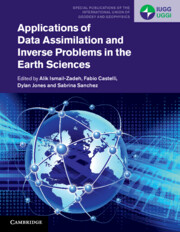Book contents
- Applications of Data Assimilation and Inverse Problems in the Earth Sciences
- Series page
- Applications of Data Assimilation and Inverse Problems in the Earth Sciences
- Copyright page
- Contents
- Contributors
- Preface
- Acknowledgements
- Part I Introduction
- Part II ‘Fluid’ Earth Applications: From the Surface to the Space
- Part III ‘Solid’ Earth Applications: From the Surface to the Core
- 11 Trans-Dimensional Markov Chain Monte Carlo Methods Applied to Geochronology and Thermochronology
- 12 Inverse Problems in Lava Dynamics
- 13 Data Assimilation for Real-Time Shake-Mapping and Prediction of Ground Shaking in Earthquake Early Warning
- 14 Global Seismic Tomography Using Time Domain Waveform Inversion
- 15 Solving Larger Seismic Inverse Problems with Smarter Methods
- 16 Joint and Constrained Inversion as Hypothesis Testing Tools
- 17 Crustal Structure and Moho Depth in the Tibetan Plateau from Inverse Modelling of Gravity Data
- 18 Geodetic Inversions and Applications in Geodynamics
- 19 Data Assimilation in Geodynamics: Methods and Applications
- 20 Geodynamic Data Assimilation: Techniques and Observables to Construct and Constrain Time-Dependent Earth Models
- 21 Understanding and Predicting Geomagnetic Secular Variation via Data Assimilation
- 22 Pointwise and Spectral Observations in Geomagnetic Data Assimilation: The Importance of Localization
- Index
- References
16 - Joint and Constrained Inversion as Hypothesis Testing Tools
from Part III - ‘Solid’ Earth Applications: From the Surface to the Core
Published online by Cambridge University Press: 20 June 2023
- Applications of Data Assimilation and Inverse Problems in the Earth Sciences
- Series page
- Applications of Data Assimilation and Inverse Problems in the Earth Sciences
- Copyright page
- Contents
- Contributors
- Preface
- Acknowledgements
- Part I Introduction
- Part II ‘Fluid’ Earth Applications: From the Surface to the Space
- Part III ‘Solid’ Earth Applications: From the Surface to the Core
- 11 Trans-Dimensional Markov Chain Monte Carlo Methods Applied to Geochronology and Thermochronology
- 12 Inverse Problems in Lava Dynamics
- 13 Data Assimilation for Real-Time Shake-Mapping and Prediction of Ground Shaking in Earthquake Early Warning
- 14 Global Seismic Tomography Using Time Domain Waveform Inversion
- 15 Solving Larger Seismic Inverse Problems with Smarter Methods
- 16 Joint and Constrained Inversion as Hypothesis Testing Tools
- 17 Crustal Structure and Moho Depth in the Tibetan Plateau from Inverse Modelling of Gravity Data
- 18 Geodetic Inversions and Applications in Geodynamics
- 19 Data Assimilation in Geodynamics: Methods and Applications
- 20 Geodynamic Data Assimilation: Techniques and Observables to Construct and Constrain Time-Dependent Earth Models
- 21 Understanding and Predicting Geomagnetic Secular Variation via Data Assimilation
- 22 Pointwise and Spectral Observations in Geomagnetic Data Assimilation: The Importance of Localization
- Index
- References
Summary
Abstract: In this chapter, I discuss an alternative perspective on interpreting the results of joint and constrained inversions of geophysical data. Typically such inversions are performed based on inductive reasoning (i.e. we fit a limited set of observations and conclude that the resulting model is representative of the Earth). While this has seen many successes, it is less useful when, for example, the specified relationship between different physical parameters is violated in parts of the inversion domain. I argue that in these cases a hypothesis testing perspective can help to learn more about the properties of the Earth. I present joint and constrained inversion examples that show how we can use violations of the assumptions specified in the inversion to study the subsurface. In particular I focus on the combination of gravity and magnetic data with seismic constraints in the western United States. There I see that high velocity structures in the crust are associated with relatively low density anomalies, a possible indication of the presence of melt in a strong rock matrix. The concepts, however, can be applied to other types of data and other regions and offer an extra dimension of analysis to interpret the results of geophysical inversion algorithms.
Keywords
- Type
- Chapter
- Information
- Publisher: Cambridge University PressPrint publication year: 2023



